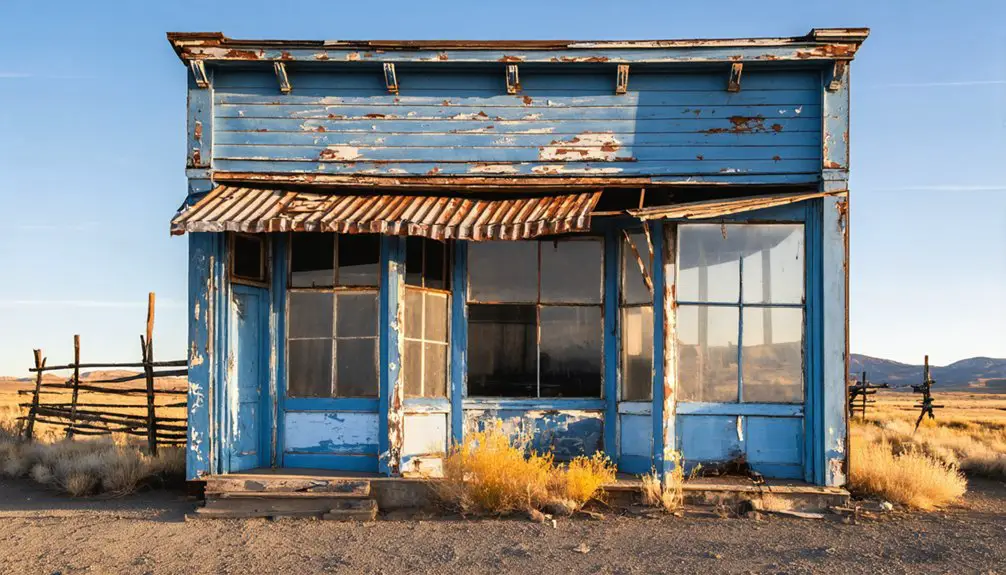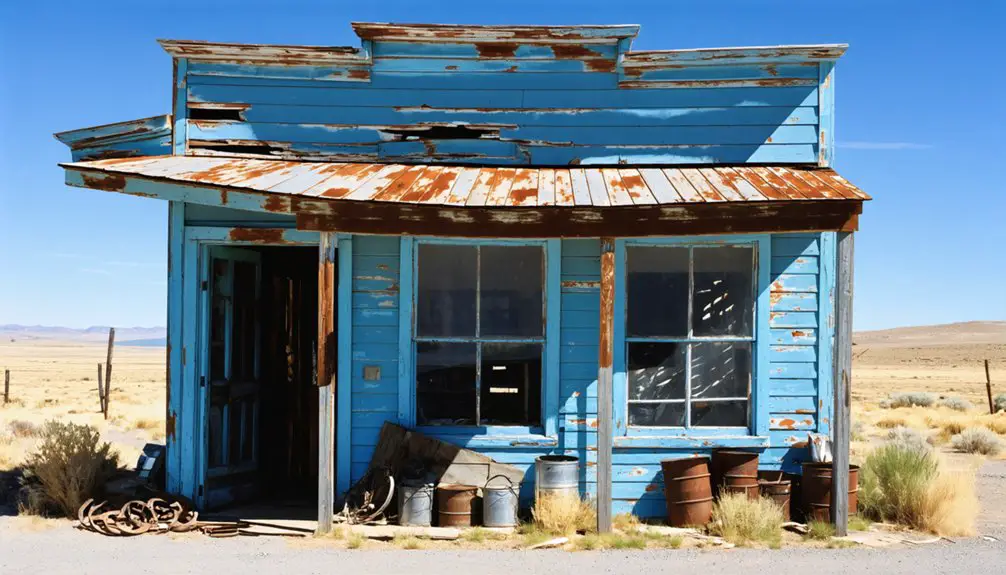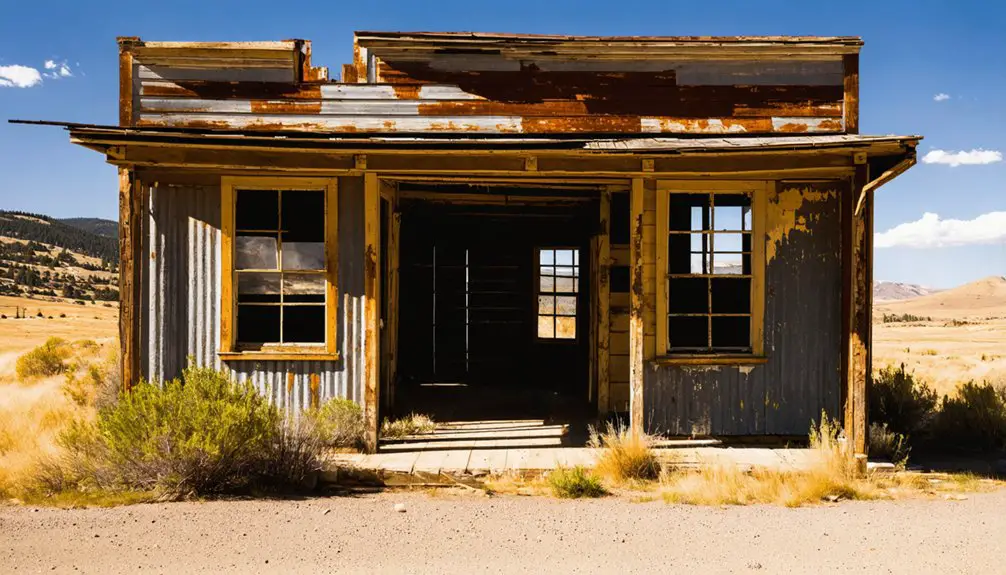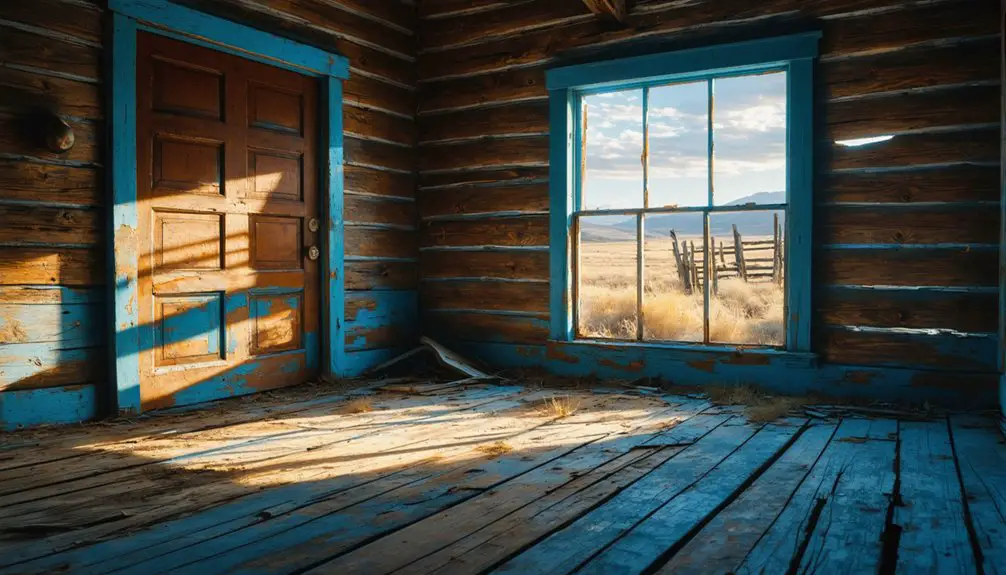You’ll discover a rugged landscape of forgotten settlements throughout Wheeler County, Oregon, where abandoned gold mines, historic lumber towns, and preserved frontier architecture tell the story of the American West’s boom-and-bust heritage. From Mitchell’s resilient community to Kinzua’s lumber legacy, these ghost towns showcase 19th-century trade routes, pressed-tin ceilings, and pioneer craftsmanship. Each weathered building and remnant mining camp holds secrets of Oregon’s rich frontier past.
Key Takeaways
- Mitchell stands as a living ghost town, featuring preserved 140-year-old buildings like the Winebarger House and historic 1884 schoolhouse.
- Wheeler County’s ghost towns emerged from 19th-century gold rushes along trade routes, with many settlements failing due to ore depletion.
- Kinzua, once Wheeler County’s largest logging community with 700 residents, represents the region’s timber industry heritage.
- Remnants of mining camps and trading posts along the John Day River showcase the area’s boom-and-bust mining settlement history.
- Historic structures throughout Wheeler County feature unique architectural elements like pressed tin ceilings and rubble stone foundations.
The Rise and Fall of Wheeler County’s Mining Communities
When gold and mineral discoveries emerged in Wheeler County during the late 19th century, they sparked a flurry of mining activity that would reshape the region’s landscape and demographics.
Mining techniques like quartz and placer operations drew prospectors to promising claims near the John Day River and rugged uplands, where they established bustling camps around valuable mineral deposits. Modern prospectors still analyze claim density patterns to identify potentially rich gold-bearing areas. A lack of adequate water supply severely impacted mining operations and limited the success of many claims.
Determined prospectors flocked to the John Day River’s promising terrain, building makeshift camps to extract precious minerals from the earth.
Community dynamics rapidly evolved as mining companies incorporated and populations swelled. You’ll find evidence of the era’s ambition in the infrastructure they built – from rough roads to quartz mills.
While some operations flourished briefly, most camps faced harsh realities. Ore depletion, economic hardships, and isolation gradually emptied these settlements.
As miners abandoned their claims for more profitable ventures elsewhere, once-vibrant communities faded into the ghost towns you can explore today.
Mitchell: A Living Ghost Town Legacy
You’ll find Mitchell’s resilient spirit reflected in its historic structures, where pioneer-era buildings stand alongside modern amenities serving today’s travelers and ranchers.
While many Wheeler County mining towns faded into obscurity, Mitchell transformed from a gold rush supply stop into an essential gateway for Painted Hills tourists, maintaining its frontier character despite devastating floods and fires.
Like nearby Richmond Post Office, which operated until 1952, the town’s living ghost town status emerges from its ability to preserve tangible connections to its mining past while sustaining an active community that honors its pioneer heritage through continued occupation and adaptive reuse of historic spaces.
The town’s history is deeply rooted in its role as a vital stop along the Dalles-Canyon City Road, which transported gold from the region’s rich mining operations to Portland and The Dalles.
Historical Buildings Still Standing
Mitchell’s living ghost town legacy is powerfully preserved through its remarkable collection of historical buildings that have withstood over 140 years of time, weather, and change.
You’ll discover the architectural significance of the Winebarger House/Central Hotel, built around 1874, with its distinctive Craftsman details and historic wood windows. The town’s educational heritage lives on in the 1884 schoolhouse, which survived multiple natural disasters and remains an indication of historical preservation.
The town’s endurance through four major floods and a devastating fire in 1899 showcases the resilient spirit of this historic community. Similar to the town of Andrews, Mitchell became a sparsely populated area with period structures maintaining its historical character. As you explore Main Street, you’ll find remnants of Mitchell’s bustling past, including former commercial buildings that once housed newspapers, banks, and stores.
The historically significant church stands as a reminder of frontier spirituality, while the surrounding cemeteries tell silent stories of early settlers and their enduring impact on this remarkable community.
Mining Town Meets Present
Beyond the historical structures that dot Mitchell’s landscape lies a remarkable story of perseverance through catastrophic events.
You’ll find a town that’s refused to fade into Oregon’s mining history, despite enduring devastating floods and fires since 1884. Through each disaster, including a thirty-foot wall of water in 1904, Mitchell’s residents demonstrated extraordinary town resilience by rebuilding and adapting.
Today, you can experience this living ghost town‘s transformation from an essential mail route stop to a gateway for Painted Hills tourism. Mitchell proudly carries the name of former U.S. Senator John Mitchell.
While many original buildings were lost to nature’s fury, the community’s spirit remains unbroken. You’ll discover modern amenities like gas stations and ice cream shops alongside preserved frontier architecture, as Mitchell continues to reinvent itself while honoring its rugged past.
Community Preserves Pioneer Spirit
While many Western ghost towns have faded into obscurity, the preservation of Mitchell’s pioneer spirit stands as a tribute to community determination.
You’ll find a town that’s weathered devastating floods, fires, and economic shifts, yet refuses to surrender its identity. Despite its modest population of around a hundred residents, Mitchell maintains its role as an essential hub for ranchers, travelers, and adventurers exploring the Painted Hills.
The town’s evolution reflects both preservation and adaptation. Local traditions continue through renovated historical buildings, while community events celebrate Mitchell’s frontier heritage. Visitors can enjoy authentic local flavors at the Sidewalk and Pine cafes.
You can experience this living history through the town’s craft brewery, cycling hostel, and preserved structures – all evidence of a pioneering spirit that transforms challenges into opportunities for renewal.
Lost Settlements Along Historic Trade Routes
You’ll find Wheeler County’s forgotten settlements carefully positioned along essential nineteenth-century trade corridors that once bustled with wagon traffic between the Columbia River and eastern Oregon’s interior.
The promise of gold sparked the development of these routes, as prospectors and merchants carved paths through the county’s challenging terrain, establishing stopping points that would evolve into nascent communities.
Travelers navigated through rugged landscapes marked by sagebrush and rimrock, which characterize the region’s distinctive topography.
These historic thoroughfares, which originally served freight wagons and stagecoaches, remain visible today through the remnants of settlements like Richmond, where crumbling foundations mark the intersections of once-thriving trade networks. The old Methodist Church continues to host special occasions, offering a rare glimpse of Richmond’s former glory as a commercial hub.
Transportation Corridors Shaped Towns
As transportation networks carved through Wheeler County’s rugged terrain, they birthed a network of settlements that rose and fell with changing trade routes.
You’ll discover how transportation evolution shaped the destiny of these frontier towns, from river ports to railway hubs. When the Columbia Southern Railway established its presence, communities flourished around depots, transforming into vibrant centers of commerce.
- Stand where bustling wool warehouses once shipped fortunes across the region
- Explore abandoned rail stations that once connected remote ranchers to distant markets
- Walk the old trade routes where indigenous paths became crucial economic lifelines
Economic shifts proved merciless as new highways bypassed established routes and modern rail lines rendered once-essential stops obsolete.
These changes left behind silent testimonies to Wheeler County’s dynamic past, where transportation determined survival or abandonment.
Gold Rush Trade Paths
The 1861 gold rush carved new economic pathways through Wheeler County, transforming quiet river banks and indigenous trails into bustling trade corridors.
You’ll find remnants of these crucial trade routes along the Columbia and Snake Rivers, where steamboats once transported thousands of fortune-seekers in surprising luxury. The Oregon Steam Navigation Company dominated these waterways, moving essential supplies between major hubs like The Dalles and Walla Walla.
You can trace these historic trade paths by following the John Day River, where ghost towns reveal the boom-and-bust cycle of mining settlements.
While Wheeler County had fewer rich deposits than neighboring Grant County, you’ll discover abandoned trading posts and mining camps that once thrived on the constant flow of prospectors, equipment, and supplies moving through the region.
Wagon Routes’ Lasting Impact
While pioneers carved initial paths through Wheeler County’s rugged landscape, formal wagon roads soon emerged as crucial arteries of commerce and settlement. You’ll find the wagon road significance etched into the county’s abandoned settlements, where toll road evolution transformed simple paths into chartered commercial routes by the 1860s.
These historic thoroughfares left an indelible mark on Wheeler County’s development:
- Trading posts and tollgate stations sprang up along wagon routes, creating essential rest stops for weary travelers.
- Chinese laborers shaped the infrastructure, building roads that defined settlement patterns.
- Ghost towns now stand as silent sentinels where once-thriving communities relied on wagon traffic.
Today, you can trace these forgotten pathways where early Oregonians forged their dreams of freedom, their legacy preserved in the quiet ruins dotting the countryside.
Kinzua’s Lumber Heritage and Decline
Founded in 1927 by pioneering lumberman E.D. Wetmore, Kinzua emerged as Wheeler County’s largest logging community, leaving an indelible legacy in Oregon’s timber history.
You’ll find its origins traced to a 50,000-acre timber operation that grew into a thriving company town of 700 residents.
At its height, you could experience a self-contained community complete with 125 company-owned homes, stores, and even a six-hole golf course.
The Condon, Kinzua and Southern Railroad connected the bustling mill to broader markets, while employing 330 workers during peak production.
Preserving Wheeler County’s Abandoned Architecture

Standing as silent witnesses to Wheeler County’s rich past, dozens of historically significant structures face mounting preservation challenges across the region’s ghost towns.
These architectural treasures maintain high architectural integrity but require innovative preservation strategies to survive. You’ll find remarkable features like original pressed tin ceilings, rubble stone foundations, and historic wooden window frames that tell the story of pioneer craftsmanship.
Pioneer craftsmanship shines through every pressed tin ceiling and stone foundation, silently pleading for preservation before time claims these architectural treasures forever.
- Feel the echoes of bustling commerce in Fossil’s century-old mercantile buildings
- Experience authentic frontier life through the untouched interiors of Richmond’s original homes
- Connect with your heritage inside the still-standing Wheeler County Courthouse
Despite economic challenges, these structures remain essential to Wheeler County’s identity, offering you a chance to explore authentic pieces of Oregon’s architectural legacy while supporting local preservation efforts.
Ghost Town Classifications and Exploration Guide
As you explore Wheeler County’s ghost towns, you’ll encounter settlements that fall into distinct classification categories based on their current state of preservation and occupancy.
Understanding ghost town definitions helps you identify whether you’re visiting a “true” ghost town with zero residents, a “partial” ghost town with minimal population, or a tourist-oriented site maintaining its historic character.
When venturing into Wheeler County’s remote terrain, remember proper exploration etiquette: respect private property boundaries, leave structures undisturbed, and pack essential supplies for backcountry travel.
Many sites, like Shaniko, fall into Class D classification – sparsely populated with historic buildings still standing.
Before setting out, verify access routes and weather conditions, and bring detailed maps since many locations require off-road navigation.
Document your discoveries while preserving these precious windows into Oregon’s pioneer past.
Historical Sites and Landmarks Worth Visiting

Wheeler County’s rich pioneer heritage comes alive through its remarkable collection of historical sites and landmarks.
You’ll discover profound historical significance at the Julia Henderson Pioneer Park, established in 1903, where century-old picnic traditions continue along Sarvis Creek.
In Fossil, the county’s museum houses Oregon’s largest collection of Wheeler County photographs, while the 1909 courthouse stands as a symbol of early development.
- Richmond’s preserved Methodist Church offers a poignant glimpse into the spiritual life of early settlers, with its renovated structure still hosting ceremonies.
- Julia Henderson Pioneer Park serves as a living memorial to the Wheeler County Pioneer Association’s formation in 1899.
- Fossil Museum’s authentic artifacts, including the original post office window, provide tangible connections to your pioneer ancestors.
Frequently Asked Questions
Are There Any Native American Artifacts Found in Wheeler County Ghost Towns?
You won’t find documented Native artifacts in Wheeler County’s ghost towns, though the area holds historical significance as indigenous land. Nearby John Day basin reveals richer Native American archaeological sites.
What Wildlife Commonly Inhabits the Abandoned Buildings in Wheeler County?
You’ll find diverse wildlife species making homes of these abandoned structures, from bats and barn owls in rafters to raccoons and rodents below, while spiders, wasps, and various mammals seek shelter inside.
Can Metal Detectors Be Legally Used at Wheeler County Ghost Towns?
You’ll need explicit permission and permits due to metal detecting regulations and historical preservation concerns. Most ghost town sites are protected, requiring authorization from landowners or governing agencies before searching.
Which Ghost Towns Are Accessible During Winter Months in Wheeler County?
While others hibernate, you’re free to explore Mitchell, Antone, Spray, and Monument during winter months. These ghost towns remain accessible via maintained highways and county roads, though you’ll need 4WD for adventure.
Do Any Wheeler County Ghost Towns Have Reported Paranormal Activity?
You won’t find documented paranormal investigations or ghostly sightings in Wheeler County’s ghost towns. While local legends might exist, there’s no official record of supernatural activity in these historic frontier settlements.
References
- https://en.wikipedia.org/wiki/List_of_ghost_towns_in_Oregon
- https://kids.kiddle.co/List_of_ghost_towns_in_Oregon
- http://freepages.rootsweb.com/~gtusa/history/usa/or.htm
- http://genealogytrails.com/ore/ghosttowns.html
- https://sos.oregon.gov/archives/exhibits/ghost/Pages/other.aspx
- https://truwe.sohs.org/files/miningnotesc.html
- https://cooshistory.org/wp-content/uploads/2023/06/Timeline-of-South-Coast-History_v2.pdf
- https://westernmininghistory.com/mine-county/oregon/wheeler/
- https://www.wheelerswcd.org/files/31e1f8c5e/Wheeler+County+NHMP_update_08AUG24+compressed.pdf
- https://www.oregon.gov/dogami/milo/pages/ohmi-wheeler.aspx



